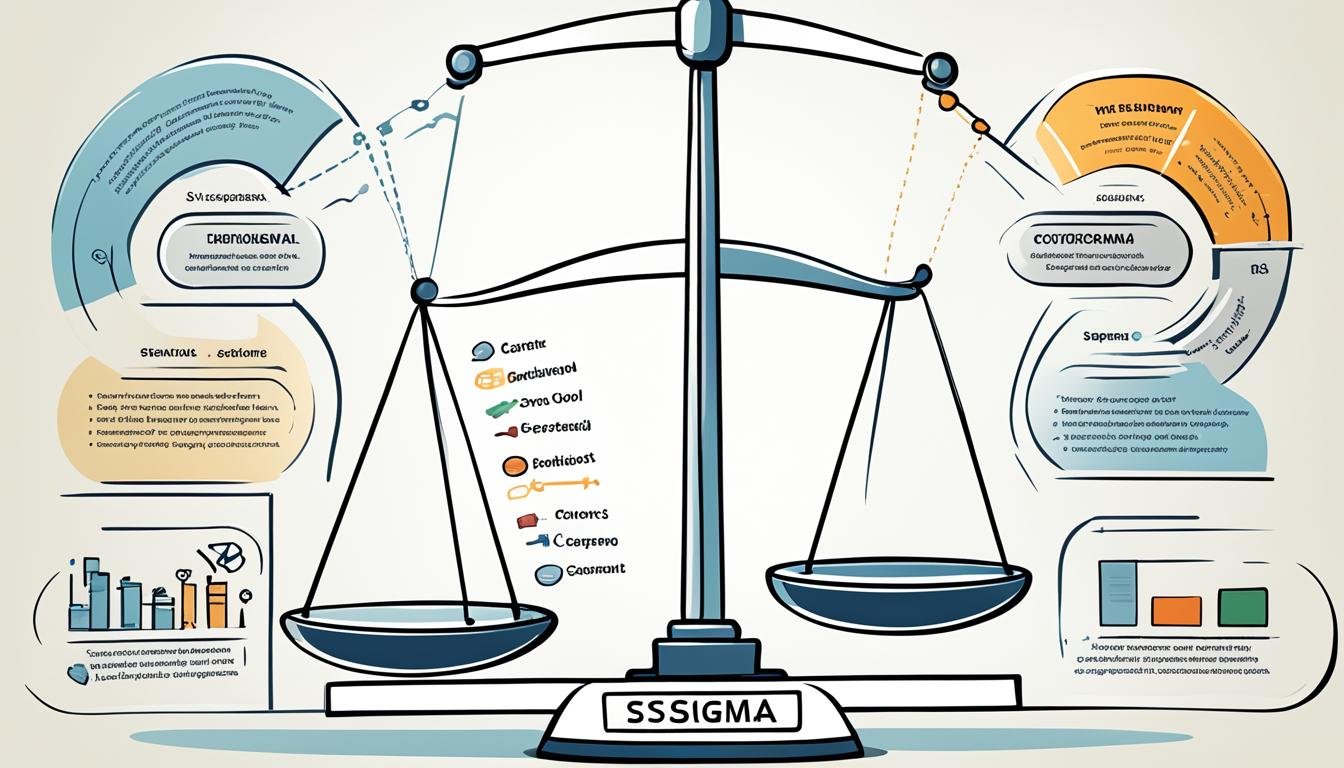Six Sigma: Achieving Perfection in Business Operations
Businesses worldwide are using a powerful method called Six Sigma to get better. But what makes this approach so special? It’s about aiming for almost flawless quality with just 3.4 defects per million chances.
Six Sigma uses data to help companies find and fix problems in their work. This leads to better quality, more efficiency, and happier customers. It’s a key part of how businesses work today, helping companies in many fields do amazing things.
What is Six Sigma?
Six Sigma is a way to measure how close a process is to perfect. A process at six sigma level has a failure rate of just 0.00034%. This means it makes almost no mistakes. Motorola created this quality management method in the 1980s. Now, it’s used by companies all over the world.
Six Sigma Methodology and Principles
There are two main ways to use Six Sigma: DMAIC (Define, Measure, Analyze, Improve, Control) and DMADV (Define, Measure, Analyze, Design, Validate). It’s built on five key ideas: customer focus, measuring the value stream, eliminating waste, continuous improvement, and a flexible and responsive ecosystem.
- Aiming for Six Sigma quality means fewer than 3.4 defects per million chances (DPMO).
- Lean Six Sigma helps cut waste and mistakes, and makes work more consistent.
- Microsoft used Six Sigma to make servers run better, increase productivity, and make customers happier.
“Six Sigma was trademarked by Motorola in 1993, aiming for a defect-free process 99.99966% of the time, allowing for 3.4 defective features per million opportunities.”
Many organizations, like companies and universities, offer Six Sigma training. These programs have different levels, from Executive Leadership to Green Belts.
Lean Six Sigma: A Powerful Combination
Lean Six Sigma is a powerful way to improve processes. It combines Lean and Six Sigma’s strengths. This mix helps organizations boost efficiency, quality, and customer happiness.
Lean focuses on cutting down waste, like overproduction and waiting. Six Sigma uses tools to reduce defects and improve processes. Together, they help solve problems with unknown causes.
By merging Lean and Six Sigma, companies can improve continuously. Lean Six Sigma training has belts to show different levels of skill. This leads to better work experiences and happier customers, which means more loyalty and more money.
Lean Six Sigma is great for cutting waste and reducing defects. Companies that use it well get ahead by offering top-quality products and services. It’s key for success in today’s fast-paced market.
“Lean Six Sigma is a powerful approach that combines Lean and Six Sigma methodologies to enhance efficiency and customer satisfaction in business operations.”
Six Sigma: Achieving Perfection in Business Operations
The Six Sigma Process and Tools
Six Sigma uses a structured approach called DMAIC (Define, Measure, Analyze, Improve, Control). This method aims to cut down on defects and get close to perfect quality. It does this by tackling business challenges step by step.
The first step, Define, is about clearly defining the problem from the customer’s view and setting goals. Then, the Measure phase quantifies the problem by setting up metrics to track progress.
The Analyze phase digs deep into the process to find the main causes of variation. Next, the Improve phase tests and puts into action potential solutions to make the process better. Finally, the Control phase makes sure the improvements last over time.
Six Sigma uses six sigma tools like process mapping, root cause analysis, statistical analysis, and DMAIC calculators. These tools help make data-driven decisions and push for continuous improvement.
“Six Sigma processes aim for a failure rate of only 0.00034%, demonstrating a relentless pursuit of perfection.”
By using the DMAIC method and these six sigma tools, companies can improve their processes and quality. This leads to delivering great value to their customers.
Big companies like General Electric, Toyota, and Amazon have used Six Sigma successfully. They show how it works well in different industries. As companies aim for top performance, Six Sigma’s methods and tools are key in their quest for perfection.
Benefits of Six Sigma in Operations Management
Six Sigma is a powerful tool for managing operations. It helps reduce defects and variation in production. This leads to improved quality and customer satisfaction. The data-driven approach of Six Sigma also helps identify and eliminate waste. This results in increased efficiency and cost savings.
Six Sigma focuses on continuous improvement. It ensures operations are always up to date with customer needs. The DMAIC (Define, Measure, Analyze, Improve, Control) method is the core of Six Sigma. It helps organizations find and fix the root causes of problems for lasting improvements.
Using Six Sigma tools like Lean, DFSS (Design for Six Sigma), and Six Sigma calculators can make operations management better. These tools help streamline processes, cut waste, and make sure new products meet Six Sigma quality standards.
Adding Six Sigma to operations management leads to better-quality products and services, higher customer satisfaction, and more profit for companies. By adopting Six Sigma, businesses can work more efficiently and effectively. They stay focused on continuous improvement in a changing world.
Implementing Six Sigma in Operations
Businesses aim for top performance across all sectors. Implementing Six Sigma in operations uses a detailed, data-focused way to keep improving. The Six Sigma methodology uses DMAIC (Define, Measure, Analyze, Improve, Control) to make current processes better. DFSS (Design for Six Sigma) is used for making new processes or products.
To put Six Sigma into action, companies use Six Sigma tools and techniques. These include Lean methods, process mapping, root cause analysis, and Six Sigma calculators. These tools spot and fix problems, making quality, efficiency, and customer satisfaction better.
Six Sigma Approaches and Tools
The DMAIC methodology is a step-by-step way to improve. It has five phases:
- Define: Clearly define the problem or opportunity for improvement.
- Measure: Gather and analyze data to understand the current process performance.
- Analyze: Identify the root causes of the problem.
- Improve: Implement solutions to address the root causes and improve the process.
- Control: Establish controls to maintain the improved process performance.
Lean principles are also used in Six Sigma to cut waste and boost efficiency. Six Sigma calculators and other tools help measure and analyze processes. This leads to better decisions and ongoing improvement.
“Implementing Six Sigma in operations can lead to a 50% reduction in defects and significant cost savings for organizations.”
By using Six Sigma approaches and tools, companies can see big improvements in their operations. This helps them stay competitive and succeed.
Six Sigma Training and Certification
Mastering six sigma training needs special training and six sigma certification. The Six Sigma belt system has Green Belts, Black Belts, and Master Black Belts. It offers a clear path for learning Six Sigma principles and tools.
These six sigma certification programs teach about DMAIC and DMADV, statistical analysis, process optimization, and continuous improvement. Getting Six Sigma certified shows you know how to use the Six Sigma method for business change and process betterment. This leads to better work performance and happier customers.
The six sigma belts certification choices are:
- Six Sigma Yellow Belt – Gives a basic grasp of process improvement ideas and tools.
- Six Sigma Green Belt – Teaches leaders about data analysis, finding root causes, and managing quality improvement projects.
- Six Sigma Black Belt – Is for those leading Six Sigma projects. It covers complex stats, testing hypotheses, and leadership.
- Six Sigma Master Black Belt – Shows experts in leading big changes in organizations and improving performance.
The six sigma training and certification process involves:
- Finishing a training course
- Passing a detailed online test
- Having personalized coaching sessions
- Presenting a project that shows how Six Sigma works in real life
Certification from places like the Kaizen Institute is known worldwide. It’s a sign of excellence in the field.
Teachers from these places have lots of experience with successful projects, even in big companies. They give real advice to help you get good at Six Sigma. The training can be tailored for different companies and for people at any skill level.
“Six Sigma certification boosts your job skills and career chances. It shows you’re good at making things better and opens up higher jobs with better pay.”
Conclusion
Six Sigma is a powerful way to make businesses better. It uses data and focuses on what customers want. This helps companies cut down on mistakes and make things more consistent.
By using Six Sigma and Lean together, called Lean Six Sigma, companies can get rid of waste. This makes them work more efficiently.
Tools like DMAIC and DFSS help companies keep getting better. They make customers happier and increase profits. Companies like GE, Motorola, and Honeywell have seen big improvements in quality and sales.
It’s important to train and certify key people in Six Sigma. This helps make sure it works well and lasts. With Six Sigma, businesses can reach a high level of quality. This makes customers happy and helps the company grow and compete better.
Source Links
- Six Sigma Certifications – Starting Only $49 – Affordable Certifications, Free Books! 50% Off Until Early Next Week!
- Six Sigma(6σ): Process Perfection
- What’s Lean Six Sigma, and how can you use it?
- What Is Six Sigma? Concept, Steps, Examples, and Certification
- What is Six Sigma? Streamlining quality management
- Lean Six Sigma: Definition, Principles, and Benefits
- Lean Six Sigma Combining Best Practises For Business Growth
- BPM+ Health: Revolutionizing Healthcare Through Standardized Processes and Interoperability
- What is Six Sigma? Everything You Need to Know in 2024 | Simplilearn
- What is Six Sigma? Everything You Need to Know | Comprehensive Guide
- Six Sigma in Operations Management: Tools, Benefits, Use Cases
- Six Benefits of Six Sigma
- Striving for Perfection: Implementing Six Sigma in Manufacturing – FasterCapital
- Mastering Six Sigma for Optimal Business Performance and Quality
- Six Sigma in Operations | Jaro Education
- Operational Excellence | Lean Six Sigma | 6 Sigma
- From Zero to Green Belt: Mastering Six Sigma Certification for Operational Excellence
- Six Sigma Belts | KAIZEN™ Training & Certification
- Six Sigma Stories: How Top Companies Achieve Success
- Achieving Operational Excellence: The Synergy of Six Sigma and Lean Integration





